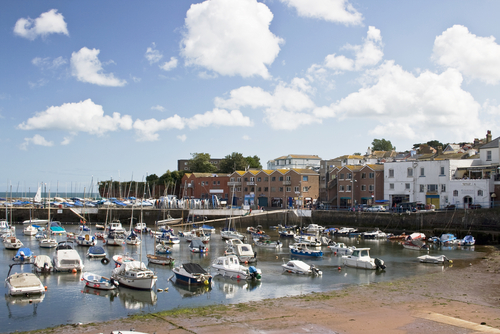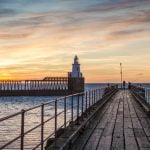
A quick guide to Paignton
Paignton is a seaside town on the coast of Tor Bay in Devon, southwest England. Paignton along with Torquay and Brixham forms the borough of Torbay, a tourist destination that has been dubbed ‘the English Riviera’. Paignton is around 25 miles (40 km) northeast of Plymouth and 20 miles (32 km) south of Exeter. In the UK Census of 2011, Paignton’s population was recorded as 49,021, making it the 4th most populace settlement in the county.
A Fleeting History
Early Times
The Paignton area is thought to have been first occupied by the Celts who are said to have settled the lowlands of Cornwall between 1500 – 600 BC. The first written reference of ‘Peintone’ is in the Domesday Book of 1086, part of the ancient hundred (administrative district) of Kerswell. Paignton’s Anglo-Saxon name is thought to be derived from “Paega”, a personal name, ‘ing’ meaning ‘the people of’, and ‘ton’ meaning ‘homestead’ or ‘estate’.
Paignton grew up on the flat dry ground between the sea and the foot of the surrounding rolling hills, gradually growing to encompass the separate fishing hamlet of Roundham Head. The village got its first church, probably a timber structure, sometime in the 8th century. In 1050, the ownership of Paignton and the surrounding area fell to that of Leofric, the first Bishop of Exeter. Later bishops would build and maintain a palace at Paignton. Some of which still remains, most notably the Coverdale Tower. In 1294, Paignton was granted borough status, giving it the right to hold a weekly market and an annual fair.
The 19th Century
Paignton remained nothing much more than a small fishing and farming village until the 19th century. In 1801, the year of the first national census of Great Britain, the population of Paignton was recorded as 1,575. The Paignton Harbour Act lead to the construction and opening of the town’s harbour in 1837. The first commercial ship to dock at the harbour came with a cargo of coal, timber and stone and left carrying cabbages and cider. The small privately-owned harbour was then used by small sailing vessels for the rest of the century. However, as time progressed, the harbour became less and less commercially viable, consequently, in 1935, it was sold to the local council.
In 1859, the railway came to Paignton. Built by the Dartmouth and Torbay Railway Company, it provided an important link between London and Torquay/Paignton. The opening of the line was celebrated with the making of a ‘Paignton Pudding’, a traditional way of recognising significant events in the town, dating back to the end of the 13th century. On 2 August 1859, it would very much seem that the crowd of more than 18,000 that had gathered for the opening of the railway, equally anticipated the arrival of the enormous pudding. It was reported that when the pud arrived, the huge cider-fuelled crowd rushed forward, ripping the giant dessert apart, until “not a morsel was left”.
In 1866, Paignton’s seawall was built using the local ‘breccia’ stone. The hybrid rock is made up of the fragments of various sedimentary rocks, held together by a fine-grained cementitious matrix, that was formed over millions of years.
In 1875, Oldway Mansion was completed for the American entrepreneur and inventor, Isaac Merritt Singer, who had amassed a considerable fortune from his sewing machine business. He had resided for the four previous years at Little Oldway, a house with its own grounds, close to the site of the mansion. However, Singer died not long after the main house was completed, but his son, Paris, went on to re-fashion the grand house in the style of a mini-Versaille, complete with formal Italian-style gardens.
In 1879, the impressive Paignton Pier, a 240 m long structure, was opened to much fanfare. It was designed by George Soudon Bridgman, a local architect who also designed Oldway Mansion. The pier was privately owned, having been financed by Arthur Hyde Dendy, a local barrister.
The War Years
In 1911, Torquay’s electric street trams were extended into Paignton, when the town population stood at about 11,000. The tram service was to cease in 1934, when it could no longer compete with the superior bus service. During WW1, Oldway Mansion was commandeered by the government and utilised as a military hospital for casualties returning from the Front. Tragically in 2018, during the last few months of the war, some 100 American soldiers died at the Paignton War Hospital, within a fortnight. Though, not of their injuries, but as victims of the Spanish Flu pandemic that was sweeping the world.
When WW2 broke out in 1939, Paignton’s population had climbed to over 25,000. The government saw Devon as a safe haven for the children, especially from the capital. By the end of 1940, there were hundreds of children billeted in Paignton to the point of overflowing. However, in April 1941, the town suffered its first bombing, resulting in 2 fatalities and damage to property. The Luftwaffe struck the town again in September 1942, when 13 people were killed and more than 1200 properties suffered damage to some degree. February 1943 saw more bomb damage to property, including Oldway Mansion. In November 1943, there was a further fatality from stray fire by a German fighter plane.
In 1948, the watersports events of the London Summer Olympic Games were held in Torbay. The Olympic flame was brought from London and burned at Torre Abbey Gardens in nearby Torquay for the duration of the Games.
The Modern Era
By 1960, the population of Paignton had grown to almost 30,000. On 1 April 1968, the County Borough of Torbay was formed from the merger of Brixham and Paignton Urban Districts and Torquay Municipal Borough. However, under the Local Government Act 1972, the area lost its county status. It then simply became known as the Borough of Torbay.
In 2017, the Paignton quayside, bus station, train station and parts of the town centre were earmarked for improvement under a Torbay Council regeneration scheme.
Paignton’s resident population has grown steadily since the beginning of the 20th century and is currently (2020) is estimated to be around 51,000. The economy, along with the rest of Torbay, is heavily reliant on the public sector, the service sector, and tourism. To attract tourism in a challenging market, Paignton has developed a strategy of staging events throughout the high season.
Annual Events
English Riveria Air Show
The inaugural year for Torbay Air Show was 2016, but since then the event has been renamed as the English Riveria Air Show. The two-day event is held over Tor Bay, just off the coast of Paignton, in early June of each year. In 2019, the event is estimated to have attracted some 165,000 visitors to the town.
Paignton Festival
The more than 100-year-old Paignton Festival has undergone a recent name change from the Torbay Carnival. The purpose of the free 9-day event, held in late July each year on ‘The Green’, is to raise money for local charities. There’s a funfair, shopping marquee, charity stalls, food stalls, live music, fireworks, etc., as well as a carnival procession.
Paignton Regatta
Paignton Regatta has been running for more than 170 years and is held in early August during the peak holiday season. The free 9-day event combines sailing competitions and displays held in the bay with fun and games activities held on Paignton Green. There’s the obligatory funfair, fireworks displays, stalls, live music, etc., for the duration of the event.
Other
Another annual event held in Paignton is the English Riveria Motorbike Show, which is a 3-day event held during the May bank holiday. The Paignton Harbour Festival is a 1-day event that takes place in late July. Dating back to the 18th century, it celebrates the town’s maritime heritage.
Getting there!
By Car
If you’re planning to travel by car to Paignton – it couldn’t be easier! Just take the M5 to Exeter, then keep straight on and take the A38 towards Plymouth. Turn on to the A380 at Bickham House for Paignton.
By Train
The average time for the 167-mile journey between London and Paignton is about 3.5 hours. The Great Western Railway service runs 10 trains on weekdays with a reduced service on weekends. There is a similar direct service from the Midlands but travelling from the North you will probably need to make 1 – 3 changes depending on the place and time of travel.
By Coach
National Express operate a direct bus service from London Victoria bus station. There are 3 buses per day and the journey takes about 6 hours. There’s a limited direct service from the North and the Midlands, but it’s possible you may have to change buses on the way or have a scheduled layover.
By Plane
Exeter International Airport is the nearest airport to Paignton, a distance of 28 miles. Expect the journey to take around 40 minutes by car.
Did you know?
- The first ‘Paignton Pudding’ was made in 1294 to celebrate the granting of the town’s charter. It started a tradition of baking huge puddings for town celebrations, and spawned the light-hearted term for a Paignton resident, as a “pudden eater”.
- Paignton’s first Harbour Master was a woman, the only female harbour master in the British Isles at that time. Stella Gale, daughter of a local shipbuilder, was appointed to the role in 1921 when she was only 21 years old.
- The premiere of Gilbert and Sullivan’s famed comic opera’The Pirates of Penzance’ took place on 30 December 1879 at the Royal Bijou Theatre (now demolished) in Hyde Road.
Notable residents
A few notable people with connections to Paignton are:
- Isaac Singer (1811 – 1875) – American actor, businessman and inventor, particularly noted for improvements to the sewing machine, lived in the town during the last 4 years of his life.
- Oliver Heaviside (1850 – 1925) – was a self-taught electrical engineer, mathematician and physicist, who helped change some understanding of telecommunications, maths and science, lived in Palace Avenue, Paignton between 1889 to 1897.
- Sue Barker – noted ex-professional tennis player, TV presenter and personality, was born in Paignton in 1956.
Sport In Paignton
Paignton RFC
Paignton RFC currently compete in the Cornwall/Devon League at the 8th level of the English rugby union system. Nicknamed ‘The Cherries’ they play their home games at Queen’s Park.
Paignton Saints FC
Paignton Saints FC play in Division 1 of the South Devon Football League.
Things to see and do!
Some of the recommend things to see and do in and around Paignton include:
- Paignton Zoo – has more than 250 species of animals and recognised as one of the top three animal attractions in the UK. Exotic themed gardens adjoin the zoo.
- Paignton Beach – is a mile-long strip of immaculately clean red sand, where you can hire a deckchair, a beach hut, a rowing boat or a pedal boat. The town promenade backs the beach and features a quintessential British seaside resort pier.
- Dartmouth Steam Railway – operates on the 7 miles of the old branch line between Paignton and Kingswear, along the spectacular Torbay coast. From Kingswear, you can take the ferry across the River Dart to Dartmouth. The service mainly operates between April to November.
- Greenway Estate – the splendid 18th-century mansion is the former home of world-renowned author Agatha Christie. Now a National Trust property, its 5 miles from Paignton but you can get there on the Dartmouth Steam Railway, getting off at Greenway Halt.
- Oldway Mansion – was built in the late Victorian era for the sewing machine magnet, Isaac Singer (see above). The grounds are fashioned in the style of Italian formal gardens.
- Goodrington Park (Young’s Park) – is on the site of a former burial ground for French soldiers from the Napoleonic Wars. However, it’s now a boating lake that rents out bumper boats and pedal boats. Is also features crazy golf, a bouncy castle and playground.
- Berry Pomeroy Castle – owned by the National Trust, is now a spectacular ruin with a colourful history. Work on the mansion began circa mid-16th century, but by the turn of the 18th century, it was still to be completed. The house was duly abandoned in 1700 giving rise to countless ghost stories. There’s great walks nearby and a cafe on site.
- Palace Theatre – is the oldest operating theatre in the area and can seat up to 380. The venue features contemporary touring acts, pantomimes, popular tribute acts, plays – especially, Agatha Christie, etc. It also puts on a number of workshops and shows for kids.
- Splashdown Quaywest – is the UK’s largest waterpark. It has 8 slides with varying degrees of scariness, as well as a standard swimming pool, children’s pool, an amusement arcade, various snack bars and a cafe. It’s located next to Goodington Park and is open May to September.
- Paignton Pier – is an archetype seaside resort pier structure that houses the usual children’s attractions like dodgem cars, bowling, slides, arcade games and trampolines.
Where to stay?
You can take your pick from a wide range of accommodation options in Paignton. There are prices to suit every pocket as you can choose from luxury hotels, B & Bs, guesthouses, traditional inns, self-catering accommodation, holiday parks, or campsites. For two adults sharing (or as indicated), a broad estimate of prices for the various types of ready accommodation are;
Campsite/Holiday Park: £20 – £30 pppn
B & B/Guesthouses: £60 – £80
Standard Hotels/Inns £80 – £100
3/4/5 Star Hotels £100 – £200
Moving there?
Thinking of moving to Paignton? The current (July 2020) average asking price of a property in Paignton is approximately £218,600. Flats are selling for an average of £145,800, terraced houses for £183,000 and semi-detached houses for £212,400. In the last 12 months, house prices in Paignton have decreased by around 4%.





